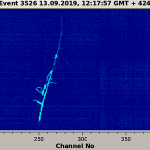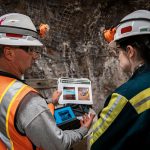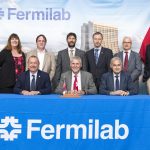From CERN, Oct. 9, 2019: Scientists working at CERN have started tests of a prototype for a new neutrino detector, using novel and very promising technology called “dual phase.” If successful, this technology will be used at a much larger scale for the international Deep Underground Neutrino Experiment, hosted at Fermilab in the U.S.
DUNE
From CNRS, Oct. 10, 2019: Les scientifiques de la collaboration ProtoDUNE au CERN ont commencé à tester un tout nouveau prototype de détecteur de neutrinos, en utilisant une technologie très prometteuse, appelée “double phase.” Si les premiers résultats obtenus se confirment, cette nouvelle technologie sera utilisée à une plus grande échelle pour l’expérience internationale DUNE aux États-Unis. Les scientifiques français du CNRS et du CEA jouent un rôle de premier plan dans le développement et la mise en route de ce détecteur innovant.
From Rapid City Journal, Oct. 10, 2019: Fermilab Director Nigel Lockyer comments on British contributions to the Deep Underground Neutrino Experiment during an Oct. 8 event in which British air power and science were feted Tuesday in Rapid City, South Dakota. Honored guests included the Royal Air Force’s Red Arrows Aerobatic Team, a British diplomat and a group of U.S. and international scientists associated with the Deep Underground Neutrino Experiment.
Scientists working at CERN have started tests of a new neutrino detector prototype using a promising technology called “dual phase.” If successful, this new technology will be used at a much larger scale for the international Deep Underground Neutrino Experiment, hosted by Fermilab. Scientists began operating the dual-phase prototype detector at CERN at the end of August and have observed first tracks. The new technology may be game-changing, as it would significantly amplify the faint signals that particles create when moving through the detector.
From Sanford Underground Research Facility, Sept. 27, 2019: Several projects are under way at Sanford Underground Research Facility to improve the reliability of the facility’s infrastructure. Crews are improving the facility for its role as the far site for Fermilab’s Long-Baseline Neutrino Facility. The LBNF project recently completed an upgrade of the main ventilation fan for the underground facility.
From pieuvre.ca, Sept. 24, 2019: Une équipe de chercheurs dirigés par Christopher Mauger, dans une étude récemment publiée, avance certaines options pouvant faire en partie la lumière sur cet étrange phénomène et répondre à d’autres questions dans le domaine de la physique fondamentale. Dans le cadre du programme CAPTAIN représentent une première étape importante pour la mise sur pied du DUNE, une installation expérimentale pour l’étude des neutrinos et de la physique des particules.
From Penn Today, Sept. 23, 2019: A team of researchers the University of Pennsylvania published results from the first set of experiments that can help answer these and other questions in fundamental physics. Their results are an important first step towards building the international Deep Underground Neutrino Experiment, hosted by Fermilab.
From the World Conference of Science Journalists, Aug. 26, 2019: In this video, Fermilab Director Nigel Lockyer participates in a panel discussion on the big questions that remain unexplained today regarding the origin, nature and ultimate fate of the universe. The other panelists are CERN Director-General Fabiola Gianotti, French National Institute of Nuclear and Particle Physics Director Reynald Pain, and University of Zürich Professor Laura Baudis. Physics Today’s Toni Feder) moderates.



